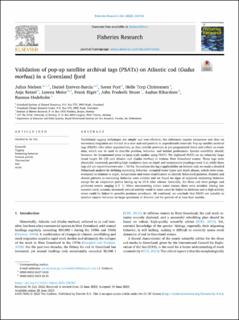| dc.description.abstract | Traditional tagging techniques are simple and cost-effective, but inferences require recaptures and data on movement/migration are limited to a start and end position at unpredictable intervals. Pop-up satellite archival tags (PSATs) offer other opportunities, as they provide positions at pre-programmed times and collect on-route data, which can be used to describe position, behavior, and habitat preferences. Species suitability should, however, be documented prior to large-scale studies using PSATs. We deployed PSATs on six relatively large (total length 84–125 cm) Atlantic cod (Gadus morhua) in inshore West Greenland waters. Three tags were physically recovered, providing high-resolution data on depth and temperature (readings every 3 s), while three tags did not report (recovery rate = 50 %). To evaluate the tag’s applicability on Atlantic cod, we made a detailed behavioral analysis by defining swimming behavior, occupied water types and depth phases, which were cross-evaluated in relation to depth, temperature and water stratification to identify behavioral patterns. Distinct and shared patterns in swimming behavior were evident and we found no signs of impaired swimming behavior except for an adaptation period lasting up to 39 h after release. Generally, the three cod were pelagic and preferred waters ranging 2–5 °C. When encountering colder water masses these were avoided. During late summer/early autumn, increased vertical activity could in some cases be linked to darkness and a high-activity event could be linked to possible predator avoidance. All combined, we conclude that PSATs are suitable to monitor natural behavior on large specimens of Atlantic cod for periods of at least four months. | en_US |
